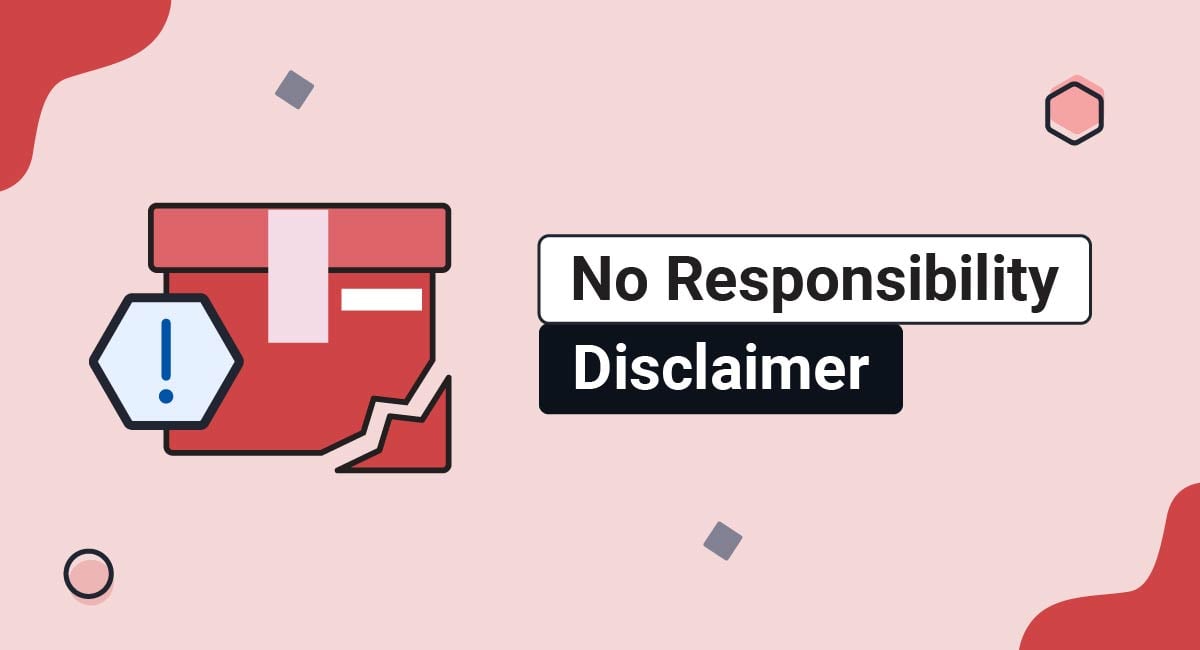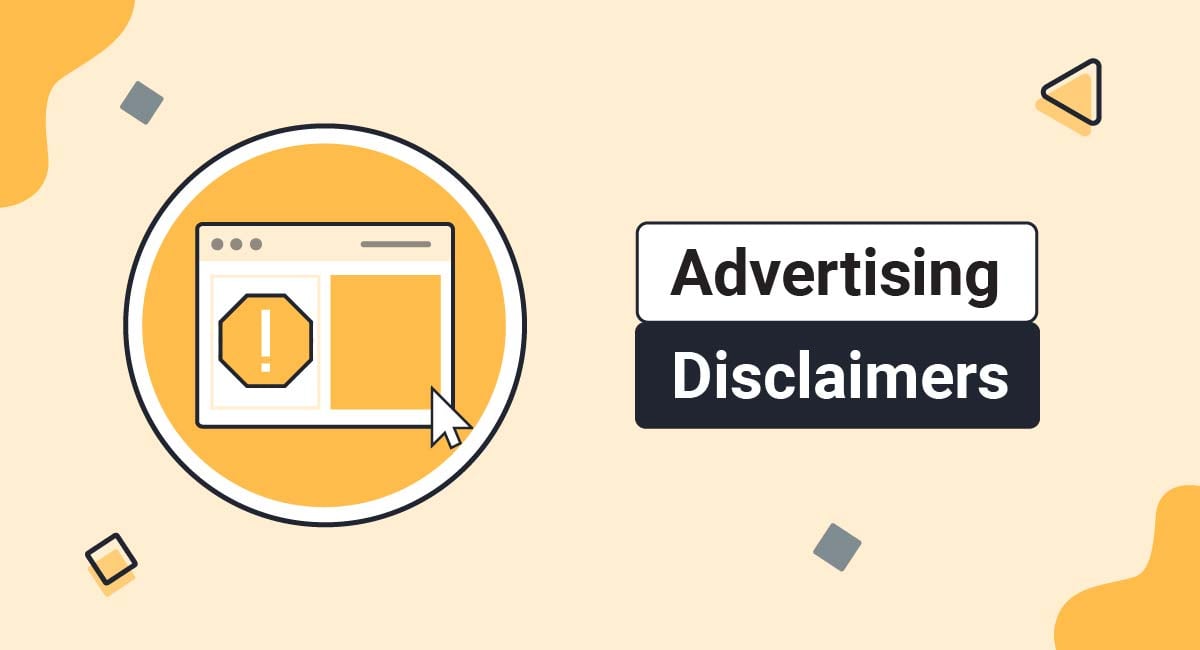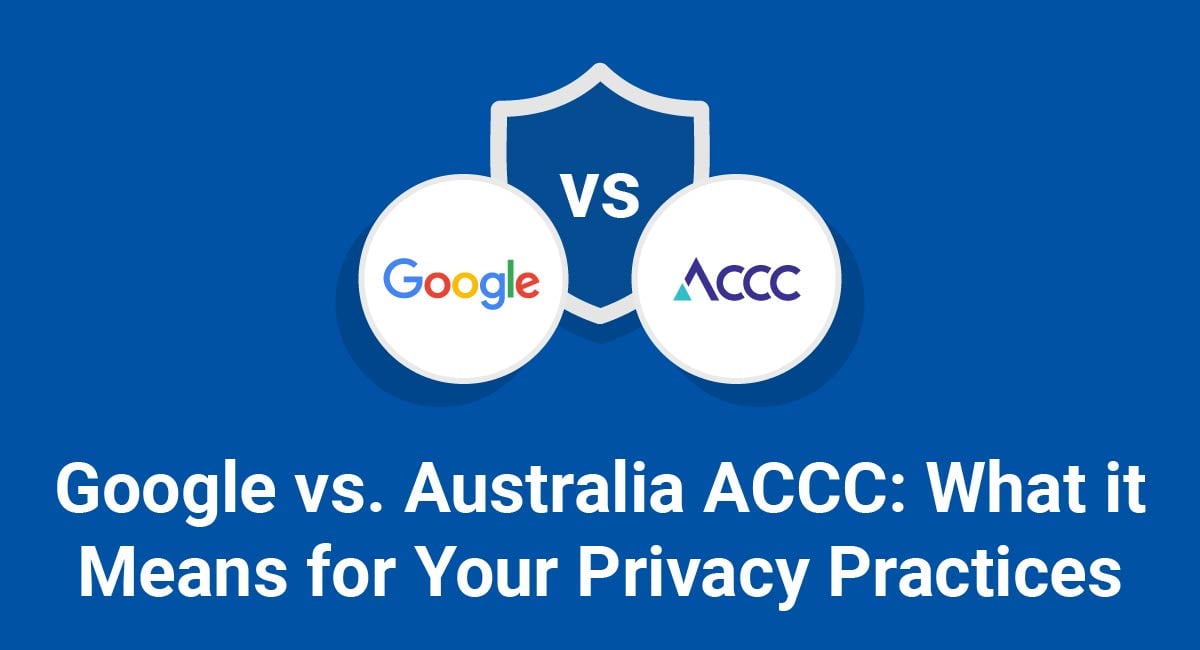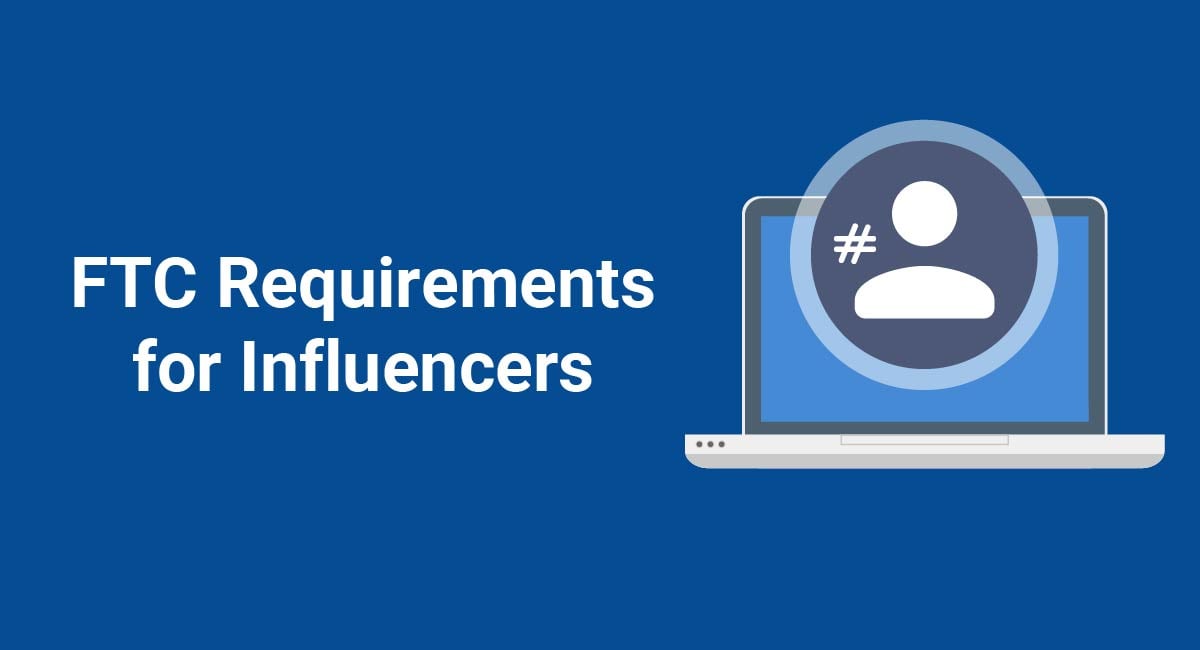A no responsibility disclaimer can serve to warn consumers of the inherent risk associated with the use of your business's products or services. It can also encourage consumers to take personal responsibility for any damage that may occur from using your products or services.
Businesses use no responsibility disclaimers to educate consumers and to help provide legal protection.
You might also hear a no responsibility disclaimer referred to as a disclaimer of liability or limitations of liability, or see it simply titled as a disclaimer.
This article will teach you what a no responsibility disclaimer is, whether it is legally required, who should have one, and how to write your own effective no responsibility disclaimer.
Our Disclaimer Generator can generate a legal disclaimer for your business, website or mobile app. Just follow these steps:
-
At Step 1, select where your Disclaimer will be used.
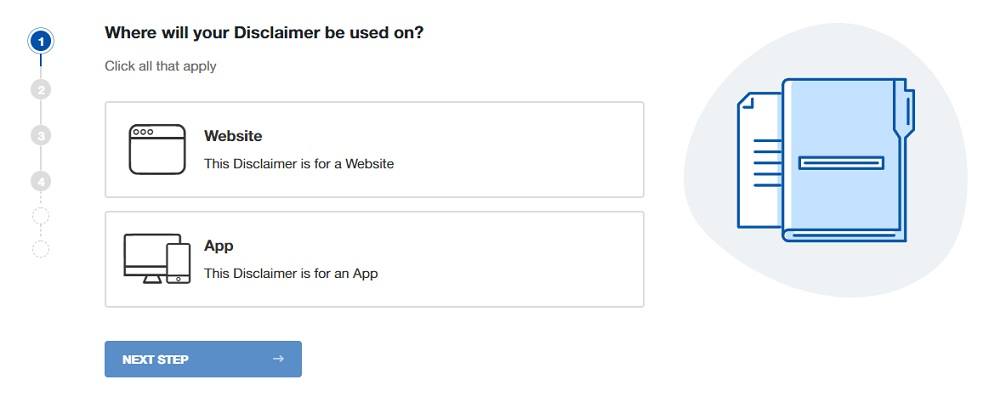
-
At Step 2, add in information about your website/app and business.
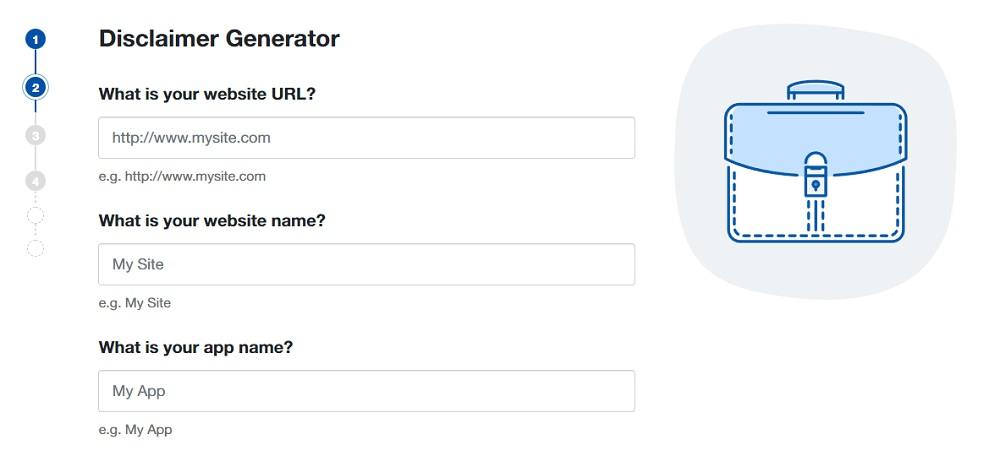
-
Answer some questions about your business practices.
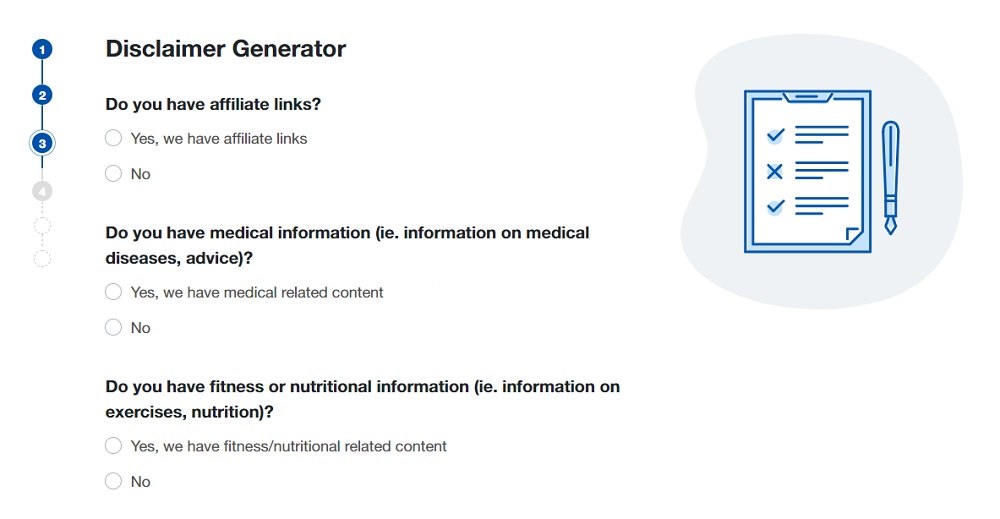
-
Enter an email address where you'd like to receive your Disclaimer and click "Generate."
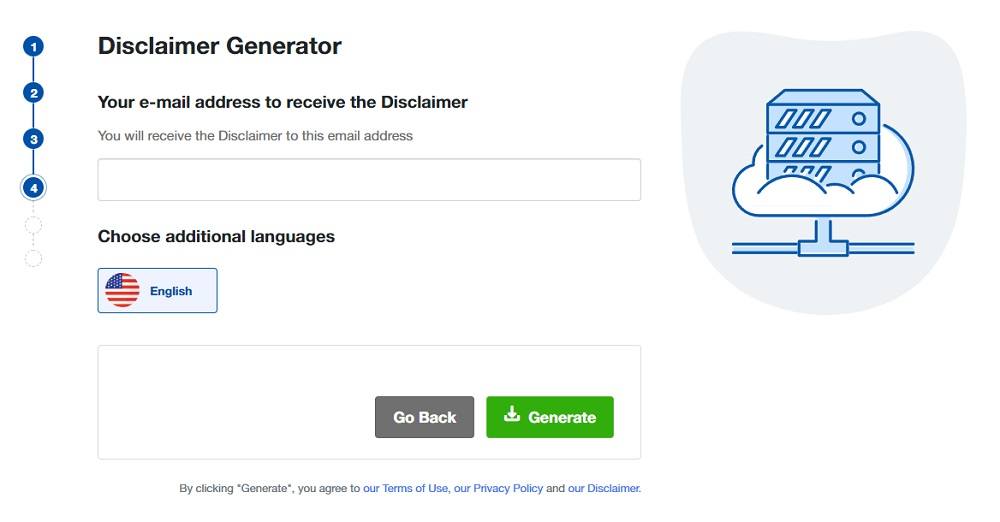
Done! You'll be able to instantly access and download your new Disclaimer.
- 1. What is a No Responsibility Disclaimer?
- 2. Are No Responsibility Disclaimers Legally Required?
- 3. Why You Should Have a No Responsibility Disclaimer
- 4. Who Needs a No Responsibility Disclaimer
- 5. What Should Your No Responsibility Disclaimer Say
- 5.1. No Control Over or Responsibility for Third Party Links
- 5.2. No Responsibility for Non-Negligent Physical Harm
- 5.3. No Guarantee of Accurate Information
- 6. Tips for Writing Your Own No Responsibility Disclaimer
- 7. Where to Display a No Responsibility Disclaimer
- 7.1. Websites
- 7.2. Mobile Apps
- 7.3. Blog Posts
- 7.4. Video Descriptions
- 7.5. Email
- 7.6. Social Media
- 7.7. Waivers/Release of Liability Forms
- 7.8. Forums
- 8. Summary
What is a No Responsibility Disclaimer?
A no responsibility disclaimer is a statement that explains that your business is not to be held responsible for any damages, injuries, or losses that occur while using your website, apps, products or services.
This type of disclaimer can serve to inform consumers of any risks that may be involved with your products or services, and to discourage legal action should damages occur as a result of doing business with you.
Are No Responsibility Disclaimers Legally Required?

While no responsibility disclaimers are not legally required, it's still a good idea to include them as a part of your business's legal protection plan.
For example, let's say someone suffered an injury while using one of your products and then took you to court. You could use the existence of your no responsibility disclaimer as evidence showing that you took precautionary steps to notify your consumers that your business was not liable for any potential negative consequences of using your product.
Maintaining a no responsibility disclaimer on your website or app can also help to dissuade users from taking legal action against you. A no responsibility disclaimer informs users that they should agree to accept personal responsibility for their results when they use your product or service.
Why You Should Have a No Responsibility Disclaimer
No matter what kind of product or service you sell, you should consider using a no responsibility disclaimer. A no responsibility disclaimer can:
- Help build trust with your consumers by showing them that you are honest
- about what your responsibilities are and what your expectations for your consumers are
- Serve as a warning of the potential consequences of using your product or service
- Help to protect you in a lawsuit (as long as your company isn't negligent)
- Help dissuade people from trying to sue you
Who Needs a No Responsibility Disclaimer

Businesses that should use no responsibility disclaimers include coaches, teachers, and any business that provides legal, health, or financial advice.
Whether your business provides services, intangible goods (such as advice or certain digital products) or tangible products (any physical item that you sell), you should use a no responsibility disclaimer to help protect your business.
Any business that sells tangible products or services should also use a no responsibility disclaimer, as there is a risk (no matter how unlikely or small) involved with the use of any product or service.
A no responsibility disclaimer will warn consumers that there is inherent risk involved in using your product or service and will let consumers know that they need to take full responsibility for any damages that may occur as a result of doing business with you.
What Should Your No Responsibility Disclaimer Say

The content you choose to put in your no responsibility disclaimer depends on your business and the types of products or services you offer.
Here are a few points that you can disclose in this disclaimer.
No Control Over or Responsibility for Third Party Links
If your website uses third party links then you should let users know that you do not necessarily agree with or accept responsibility for the content that any third party links may contain, and that it doesn't reflect your own views or positions.
The California Department of Consumer Affairs offers a Links Disclaimer. It addresses links to other sites and notes that the department has no control over and isn't responsible for any information or content posted. It also notes that it doesn't endorse, promote or otherwise recommend any products or statements taken by the linked site:
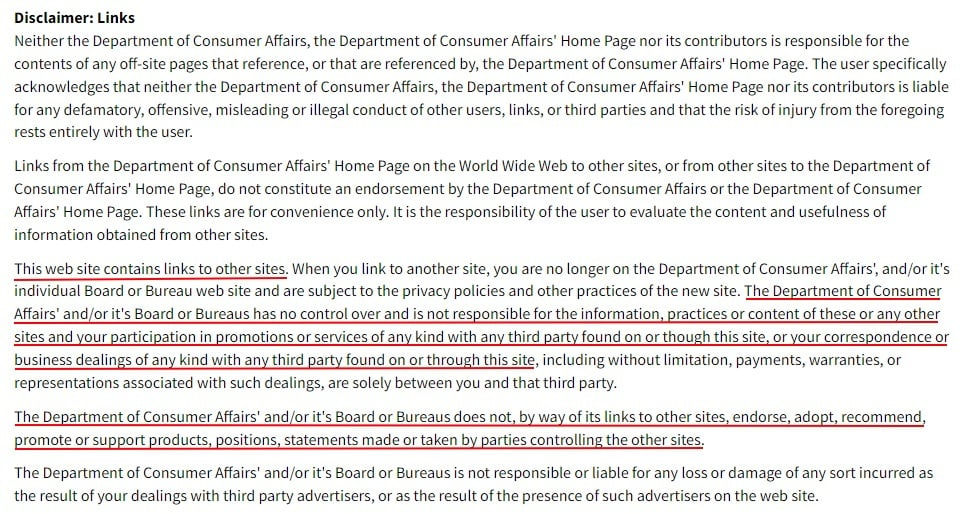
No Responsibility for Non-Negligent Physical Harm
All products or services come with some degree of risk, but if your business sells a product or service that carries obvious risk of physical harm to your consumers, then you should definitely use a no responsibility disclaimer.
This type of disclaimer is commonly seen as an "assumption of risk" statement.
Situations where you want to use physical harm liability language in your no responsibility disclaimer include whenever you:
- Sell any kind of edible product or product that people physically use
- Teach people how to exercise or use certain equipment
- Sell adventure services or products
Greystone Programs' Voluntary Skydiving Release of Liability and Assumption of Risk form includes a section about assumption of risk where an individual agrees to assume all risk while participating:
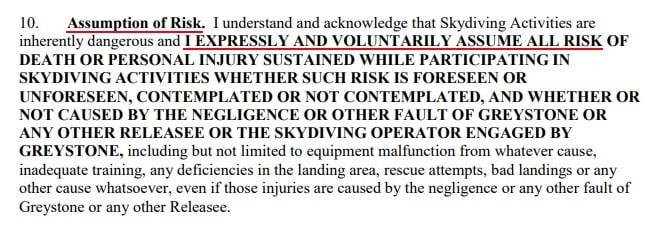
Athletic Greens' Terms and Conditions includes a Limitation of Liability disclaimer that informs users that it is not to be held responsible for any loss or damages that result from accessing its website or purchasing products from its website:
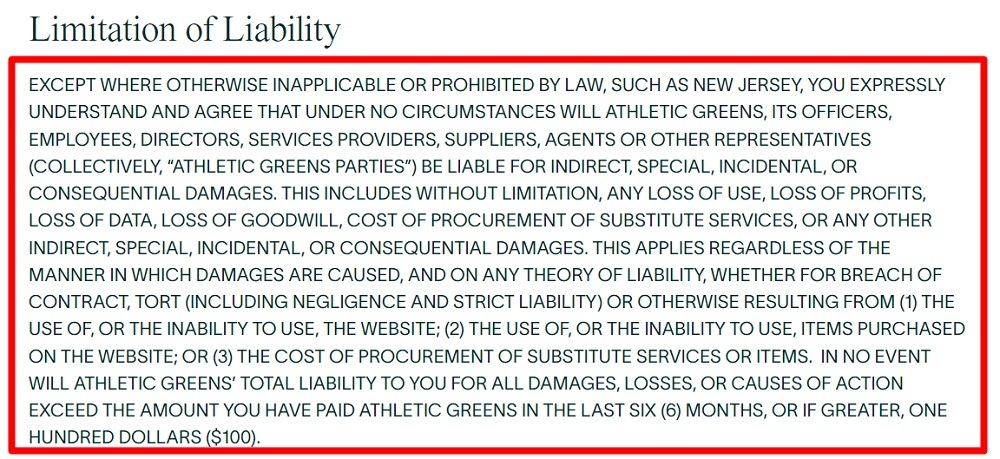
No Guarantee of Accurate Information
Your no responsibility disclaimer should inform users that you are not responsible for the accuracy of the information you share.
Delivering the most accurate information possible is essential not only because it's what makes good business sense, but also because if you don't (or if you intentionally mislead your consumers) you can get in legal trouble.
While it's crucial to strive for accuracy when providing information to your consumers, it's not always possible. Information is subject to change, and despite your best efforts, you might not always be able to provide the most up-to-date data.
The Native Hawaiian Education Association includes a statement in its Disclaimer about Information Accuracy letting users know that while it seeks to provide precise information, it does not guarantee the accuracy of any of its content:
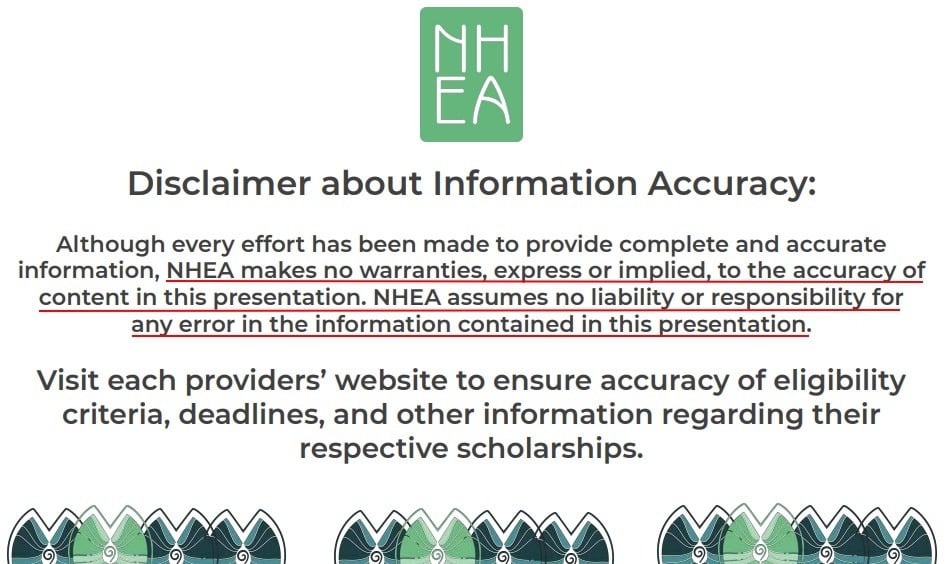
Now that you have an idea of what your disclaimer should include, let's look at some tips for writing your own.
Tips for Writing Your Own No Responsibility Disclaimer

To write your own no responsibility disclaimer, you will want to take a look at your business and decide what kind of risk using your goods or services could potentially involve. Think about it from your customers' perspective: Could using your business's website, apps, products, or services possibly result in loss, injury, or other damages?
Make sure to use concise language that is simple to understand by your average consumer.
Your no responsibility disclaimer needs to clearly convey the message that your business is not liable for any damages that may occur when people use your products or services.
Once you have created a comprehensive no responsibility disclaimer, make sure to put it somewhere people can easily find it.
Where to Display a No Responsibility Disclaimer

You should display your no responsibility disclaimer where users can easily find it. You can display the full text of your no responsibility disclaimer, or put a link to it on your website, app, blog posts, emails, video descriptions, social media, and forums, and on any waivers or release of liability forms.
Websites
A common place to put a no responsibility disclaimer is on your website. Many businesses put a link to their no responsibility disclaimers within their website footers.
To access Netflix's Limitations on Liability, users can first click on its Terms of Use link in its website footer. From there, users can scroll down to the Disclaimers of Warranties and Limitations on Liability section. This section explains that Netflix and its subsidiaries and associates are not to be held responsible for any injuries or damages sustained by its users:
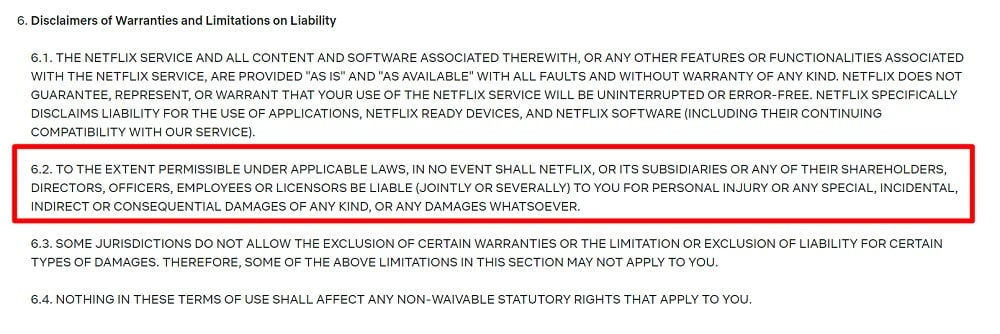
You should consider adding a no responsibility disclaimer to any apps your business has developed, which we will go over now.
Mobile Apps
Your mobile app should allow access to your no responsibility disclaimer either via the mobile app menu itself, or via a link from your app's main website.
TON Apps includes a link on its homepage to its Disclaimer page. This allows users to access its no responsibility disclaimer before downloading any apps:

Blog Posts
Another important place to put a no responsibility disclaimer is within your blog posts since the disclaimer will directly relate to the blog's content.
The American Numismatic Association maintains a web page dedicated solely to its ANA Blog Policy and Disclaimer, which states that views belong to individual blog posts' authors and that it makes no claims as to the accuracy of the information contained within the blog. The ANA lets users know that it is not responsible for any damages that may arise from the use of its blog.
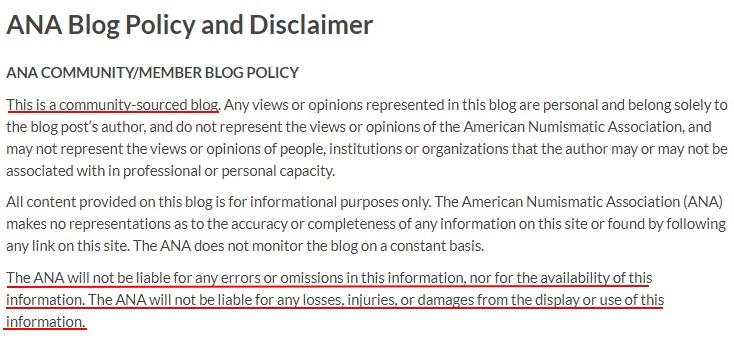
Video Descriptions
Putting a no responsibility disclaimer in your video descriptions is an effective method of informing your viewers about any risk involved in your videos' content. You can add the text of your disclaimer to a video description box when using apps such as YouTube. Another option is to add your no responsibility disclaimer text to the beginning of your videos.
Yoga with Kassandra puts a disclaimer in the video description box under her YouTube videos to let viewers know that when they watch her videos they agree to accept responsibility for any injuries that may occur while following the exercises promoted in the videos:

Many businesses add a no responsibility disclaimer to their email signatures so that the disclaimer is attached to every email sent out.
To add a disclaimer to your Gmail account, first login to your account, then open your Settings by clicking on the gear icon in the upper right hand corner:
![]()
Click See all settings, then scroll down to Signature and click Create new:

Name your new signature, then add the text of your no responsibility disclaimer to the text box:

When you're finished, scroll down and click Save Changes. Your no responsibility disclaimer should now show up at the bottom of all of your outgoing emails.
Another place you can put a no responsibility disclaimer is on your social media platforms, which we will go over next.
Social Media
Goldman Sachs includes a link to its Disclaimer under the About section of its Facebook business page:
Users can scroll down to the Additional Information header in the About section, and click on the community guidelines link:

The link takes visitors to the Goldman Sachs Social Media Community Guidelines page, which contains its Disclaimer:
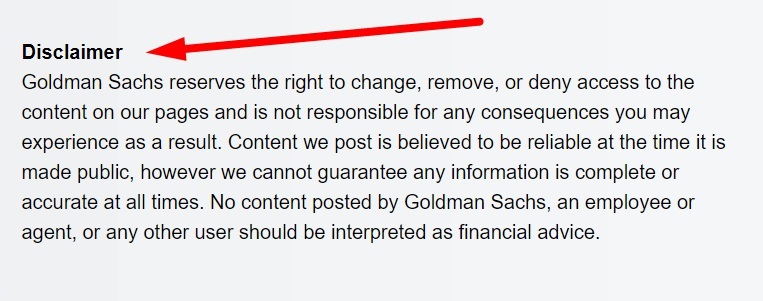
You should add a no responsibility disclaimer to any waivers or release of liability forms that your business might use, which we will cover next.
Waivers/Release of Liability Forms
Any time your business provides a potentially hazardous product or service, you should include a no responsibility disclaimer as part of your sign-up form.
Lighthouse Landing Campground uses a Boating Waiver Form to let anyone renting a boat or tube from the company know that they need to assume responsibility for any injuries or damages that may occur during the rental process:
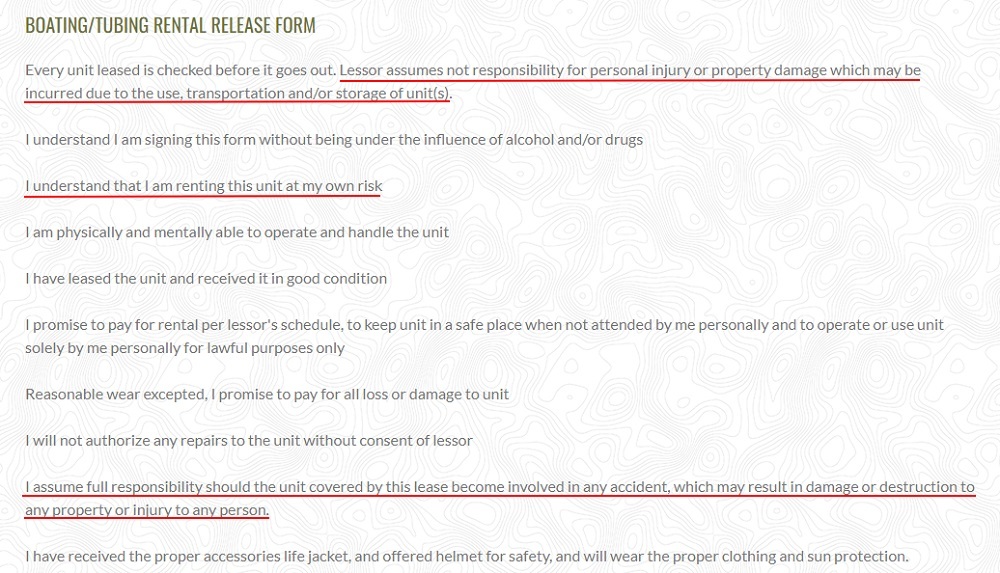
Forums
If your business hosts forums or groups on your website or through social media, then it's a good idea to post a no responsibility disclaimer to let users know that you are not responsible for any viewpoints shared by any of the commenters.
The National Alliance on Mental Illness includes information in the Use of Website Discussion Groups/Bulletin Boards/Blogs section of its Terms of Use page letting users know that it is not responsible for content or opinions posted by staff or other contributors. It also relinquishes responsibility for anything that may happen to its users as a result of following advice on any of its posts:
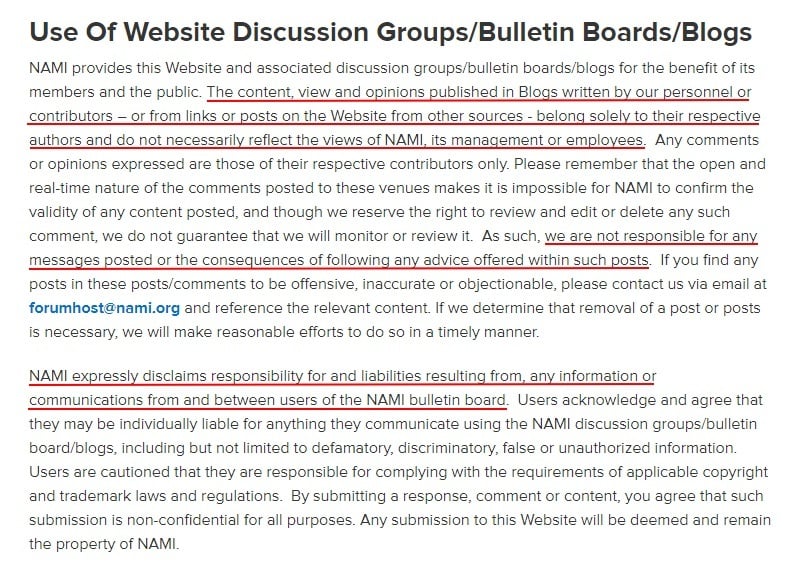
Now that we've covered different places you can put your no responsibility disclaimer, let's talk about how to write one.
Summary
A no responsibility disclaimer is a clause that helps to provide your business with legal protection. While not legally required, it's a good idea to use a no responsibility disclaimer to inform consumers of the potential risks involved with using your products or services.
Whether your business provides tangible or intangible products or services, a no responsibility disclaimer can help to inform your consumers about your limitations of liability.
What content you put in your no responsibility disclaimer depends on your business and the types of products or services it provides. You should include specific language in your no responsibility disclaimer addressing the following situations:
- Whenever you share third party links
- Whenever there is a risk of physical harm
- Whenever you share information
You can add the entirety of your no responsibility disclaimer text to a specific location, or you can create a link that takes users to a separate page designated for your no responsibility disclaimer. Common places to put your no responsibility text or link include your:
- Website
- App
- Blog
- Email signature
- Video descriptions
- Social Media
- Forums
- Waivers/Release of Liability forms
When writing your no responsibility disclaimer, you should make sure that it contains easy to understand language, is easily accessible, and clearly explains that your business is not responsible for any damages, loss, or injuries incurred through the use of your products or services.

Comprehensive compliance starts with a Privacy Policy.
Comply with the law with our agreements, policies, and consent banners. Everything is included.
